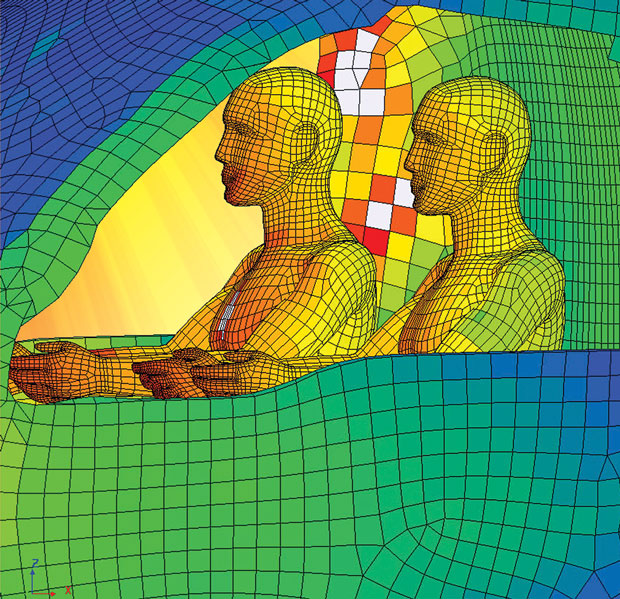Editor’s Pick of the Week: Thermal Modeling Solution Updated

The TAITherm Human Thermal Module allows engineers to test for human comfort rather than simple climate controls. This image from the ThermoAnalytics website depicts a comfort simulation using two model manikins in a Ford F-350 on an Arizona afternoon in August. Image courtesy of ThermoAnalytics Inc.
Latest News
July 1, 2015
 Dear Desktop Engineering Reader:
Dear Desktop Engineering Reader:
The environmental system in this minivan I had worked O.K. under ideal conditions, meaning stationary in the sun on cold days or in the shade on hot ones. In the real world, weather overwhelmed it. Probably because its system analyses were run under ideal, steady-state conditions in a lab somewhere rather than under more tricky real-world transient conditions. Today’s Pick of the Week write-up is about a thermal modeling solution engineered for virtual prototyping transient as well as steady-state thermal analyses. Though a little housework first.
If you’re in an industry like automotive, aerospace or manufacturing, it’s likely you know ThermoAnalytics’ RadTherm thermal management software. Launched two decades ago, it was designed to provide thermal simulation tools using transient analysis techniques. At first it was a radiation-only solver. Today, it can predict product or system temperature distributions with all kinds of heat transfer modes like conduction, convection and advection as well. So, ThermoAnalytics has renamed it TAITherm (Tee-Aye-Eye-Therm) to better reflect the software’s depth and breadth.
TAITherm represents the solution’s 12th major update. The software, which uses a multiphysics methodology to solve both steady-state and transient thermal conditions, scales to solve fast 1D models and detailed 3D models and can be deployed for virtual prototyping from the beginning of a project through to final validation. This newest release sees enhancements across most of its entire operating areas, such as post-processing, CAE coupling and its specialized Human Thermal Comfort thermal management add-on module.
TAITherm now sees distributed computing capabilities for running multi-grid and partial-direct solvers in parallel, which should give your thermal solution runs a big speed up. Also for distributed computing environments is a new Monitors tab in the graphical user interface (GUI). You can use this to select specific parts from a parts list to determine if those parts have reached convergence. Other highlights include a 10x to 100x speed increase in rendering performance, new thermal probes for comparing results from measured thermocouple locations to measurement data results, and post-processing relations that enable you to isolate or emphasize component relationships and visualize component-to-component energy contributions.
 ThermoAnalytics describes its Battery Module for TAITherm as engineered to help OEMs (original equipment manufacturers) and suppliers test, experiment and validate a battery’s thermal management optimization virtually, eliminating time, expense and risk in the process. This image here depicts a battery pack analysis with TAITherm. Image courtesy of ThermoAnalytics Inc.
ThermoAnalytics describes its Battery Module for TAITherm as engineered to help OEMs (original equipment manufacturers) and suppliers test, experiment and validate a battery’s thermal management optimization virtually, eliminating time, expense and risk in the process. This image here depicts a battery pack analysis with TAITherm. Image courtesy of ThermoAnalytics Inc.You can learn more about TAITherm from today’s Pick of the Week write-up and from the landing pages linked after the main write-up. There’s a link to request an evaluation unit, which, as always, is your best bet for really understanding a new tool. Good stuff.
Thanks, Pal. – Lockwood
Anthony J. Lockwood
Editor at Large, Desktop Engineering
Subscribe to our FREE magazine, FREE email newsletters or both!
Latest News
About the Author
Anthony J. Lockwood is Digital Engineering’s founding editor. He is now retired. Contact him via [email protected].
Follow DE





